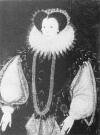Sir William
COURTENAY of Powderham, Knight
Born: ABT 1553
Died: 24 Jun 1630, London, Middlesex, England
Buried: Powderham, Devonshire, England
Notes: The Complete Peerage vol.IV,p.333. de jure
Earl by 1831 decision.
Father:
William
COURTENAY of Powderham (Sir)
Mother:
Elizabeth
PAULET
Married 1:
Elizabeth
MANNERS 18 Jan 1572/3
Children:
1.
Margaret COURTENAY
2.
Bridget COURTENAY
3.
Elizabeth COURTENAY
4.
William
COURTENAY (Sir Knight)
5.
Francis
COURTENAY of Powderham (Sir)
6.
Thomas COURTENAY
7.
George COURTENAY
8.
John COURTENAY
9.
Alexander COURTENAY
10.
Edward COURTENAY
Married 2: Elizabeth
SYDENHAM (w. of Sir Francis Drake)
Married 3:
Jane
HILL (b. 1565 - d. BEF
1615) (dau. of Robert Hill of Yarde and Eleanor Marvyn) (w. of
Sir Thomas Brereton)
The details in this biography come from the
History of Parliament, a
biographical dictionary of Members of the House of Commons.
Born
by Jun 1553, first son of Sir William Courtenay of Powderham by
Elizabeth, dau. of John Paulet, 2nd M. of Winchester. Educ. M.
Temple 1578. Married first, lic. 18 Jan 1573, Lady Elizabeth Manners, dau. of
Henry Manners, 2nd Earl of Rutland,
and Margaret Neville; secondly
Elizabeth
(d. 1598) dau. of Sir George Sydenham of Combe Sydenham, wid. of
Francis Drake; and thirdly to Jane, dau. of
Robert Hill of Yarde. Suc. family 1557. Kntd. 1576.
J.p. Devon from c.1561, j.p.q. Somerset by 1601; sheriff, Devon 1579-80, dep. lt.
1586.
After the death of his father in France, Courtenay became a ward of his
great-grandfather,
Sir William Paulet, Marquess of Winchester, who was granted some of
Courtenay's lands in return for his services. The influence of the Catholic Paulet family no doubt
partly accounts for Courtenay's own later conversion. Though his religious views would
have been repugnant to
Francis Russell, 2nd Earl of Bedford,
Courtenay was named as a deputy lieutenant in Bedford's unissued commission of 1585. He thrice represented Devon. On 14 Dec 1584 he was named to a committee for the confirmation of letters patent to
Sir Walter Raleigh, and he
may have attended the subsidy committee on 24 Feb 1585 to which he was appointed as
knight of the shire. In
1589
he was eligible to attend the
subsidy committee on
11
Feb as first knight of the shire. In
1601 he was named to a committee on the penal laws (2 Nov); as knight of the shire he was on the committee considering the
order of parliamentary business (3 Nov) and the monopolies committee (23 Nov); as one of
the knights for Devon he was on a procedural committee (11 Nov); and as a knight for a maritime county he was appointed to a committee on 3 Dec to consider measures against pirates.
While in London in 1584, Courtenay quarrelled with Richard Champernowne,
Lady Courtenay appealing for help to her brother,
Edward Manners, 3rd Earl of Rutland,
Lord Burghley and the lord chancellor
Sir Thomas Bromley investigated the matter and, wrote
Courtenay,
'In fine, we were made friends and my lords have promised me a letter of their good opinion of me, and justifying my innocence
in this cause'
Soon afterwards, both he and Champernowne were undertakers in the Munster plantation, which
may explain how Courtenay got into
the hands of moneylenders, for in 1588 he was one of 12 knights 'of great possessions' suggested for baronies. At
this time he commanded 3,000 men in Devon, and a defence force in Dorset. He was one of
the deputy lieutenants appointed by the Privy Council
to 'advise' the young lord lieutenant of Devon, the Earl
of
Bath, who was under the thumb of his ex-tutor Thomas Hinson. Bath's opinion of
Courtenay is interesting:
'a man who, though he gives himself out to all víee, as drinking, whoring etc.,
yet he neither wants wit to devise, nor might to practise how to strengthen himself and weaken others'
By 1586 Courtenay's Catholic religious views were becoming embarrassing.
His second wife, Elizabeth Sydenham, was well connected. Her paternal grandfather had been Sir John Sydenham, Sheriff of
Somerset, and his wife, who survived until 1608, was Ursula Brydges, the sister
of John, first Lord Chandos. Their extensive brood were significant local
figures. The
oldest of Elizabeth's five paternal uncles, Sir John Sydenham, inherited the
estate of Brympton d'Every. An aunt, also called Elizabeth, married the Sheriff
of Devonshire.
The father of the bride was Sir George Sydenham, sometime sheriff of Somerset, who had inherited from his father the
estate of Combe Sydenham in the same county and had added to it since. In 1561,
for example, he had purchased the manor of
Sutton Bingham from Sir William Kayleway of Rockborne. He played the local
benefactor, providing 15 pounds per year from his properties at Combe Sydenham
and nearby Stogumber for the upkeep of six cottages he had donated to poor
widows, and was
a pillar of the county administration, regularly mustering the local levies at
Bridgwater. Sir George's wife, Elizabeth, was of no less distinguished lineage
than the Sydenhams. She was the daughter of Sir Christopher Hales, once
Attorney-General to Henry VIII and the prosecutor of
Wolsey,
More, Fisher and
Anne Boleyn.
|

Elizabeth Sydenham |
Yet, although his third wife was a Catholic, it was not until
James's reign that he resigned his military offices and surrendered bis arms. It
may have been some compensation that he became deputy warden of
the stannaries. Sales of his lands continued throughout his life, but bis inquisition post mortem showed that he still retained a score of manors in Devon.
For a good many years of his life he resided in Ireland, as one of the
"undertakers" for the settlement of that country. He obtained a grant
of Newcastle, with a large quantity of the confiscated land of the Earl of
Desmond, and thus laid the foundation of the great Limerick property which has
since been enjoyed by his descendants.
He died in London on 24
Jun 1630, and was buried at Powderham.




